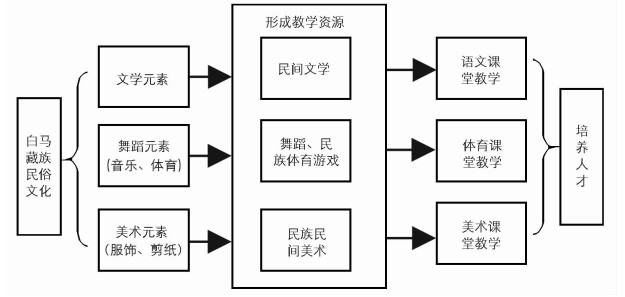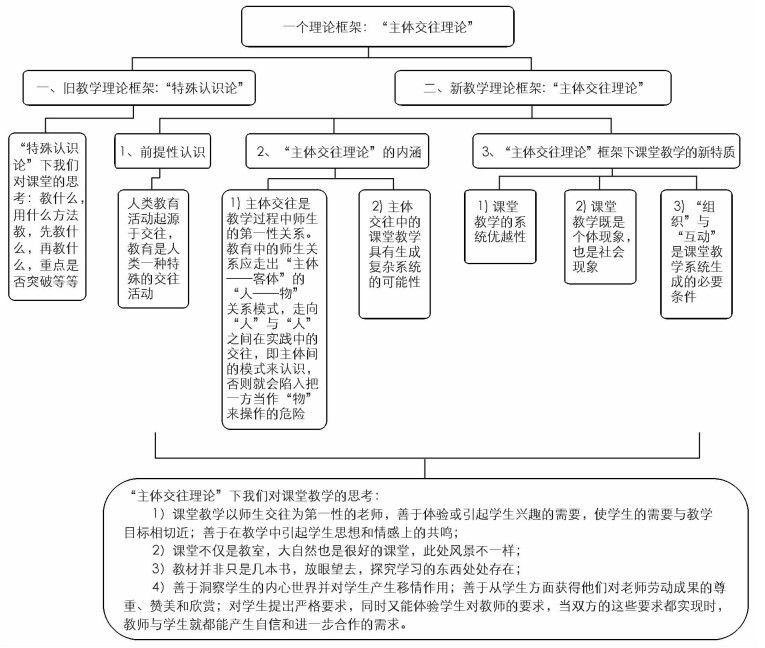-
当前,一些高职院校在人才培养中存在认识不充分、落实不到位、课程设置不合理,高校教师创新引导能力不足等问题.从文化育人的角度来审视高职院校人才培养,并以此为切入点寻求高职院校艺术课程改革,构建能够激发学生学习内生动力的创新型人才培养模式,是一种有益的探索.
具身认知(Embodied cognition)是心理学一个新兴的研究领域,该理论指出生理体验与心理状态之间有着强烈的联系,主张认知情景化,强调认知的形成与人的感觉运动系统有着直接的关联,认知、身体和环境是一个整体[1-2].我们的身体嵌入自然与社会文化环境,与环境相互作用,而文化背景对其中个体的思维、行为和对待自然的态度等都具有重大影响[3].具身认知理论启发我们在少数民族白马藏族的文化传承活动中去观察、分析其传统习俗及艺术表达方式,探索其蕴含的文化价值、艺术价值和教育价值,从而促进白马藏族文化的保护、传承与发展.白马藏族文化用具身演绎的叙事方式,潜移默化地影响着白马人的思维、语言和行为习惯,塑造着其个体的自我概念、情绪与行为方式[4].我们对白马藏族技艺的学习和研究应充分了解白马藏族文化形成的背景,找寻白马藏族文化融入高职院校人才培养的切入点,并探寻其独特性和其中蕴含着的教育价值[5-6].
四川幼儿师范高等专科学校毗邻四川省平武县白马藏区,10多年前开始对白马藏族文化中的艺术特色进行系统性的研究与探索,深入开展了高职院校艺术类课程的教学与人才培养改革.本文对该校基于白马藏族文化融入高职院校教育教学的实践探索进行了梳理.
全文HTML
-
2012年,学校成立“白马藏族文化艺术研究中心”.研究人员以研究中心为依托,常年深入平武白马藏族聚集区,进行实地调查和采访.根据具身认知理论——认知过程与环境事件紧密联系的观点,研究人员注重调查活动的情境性和实践参与性,拜非物质文化遗产传承人为师,虚心向当地群众学习和交流,主动参加当地的民族活动,特别是各种祭祀、节庆、婚庆等活动,体验白马人的喜、怒、哀、乐,真切了解白马藏族文化背景,近距离地聆听白马藏族故事、传说,学唱白马藏族歌曲,观赏和领略白马藏族剪纸、雕刻、服饰、舞蹈的艺术魅力,从独具特色的白马藏族文化中发现和挖掘教育资源.
-
白马藏族文化元素来源于实践活动,并具备重要的社会功能,它的服饰、音乐、歌舞、民俗、民间故事、传说等有着白马人独特的、鲜明的民族印记,反映了白马藏族先民们长期与自然环境和谐相处、自觉适应社会变迁的奋斗历程.具身认知理论认为,学生的学习过程同身体参与密不可分,环境条件通过身体影响学习、记忆等心智过程.学习不仅基于身体,也根植于环境,学习过程发生于文化情景中,并且受到情境因素的制约[7].白马藏族歌舞、服饰、美术作品中包含的民族文化元素来源于生活实践,表现出白马人对生活的感受和体验,呈现出独特的文化情景和文化叙事[8],正是我们需要吸取的非物质文化遗产的精华,为民族文化元素融入高职院校艺术课程的教学实践提供了有力的指导框架.
1) “做中学”是我们带领学生学习白马藏族技艺的基本方法.从简单的动作模仿到学习整套动作,从传统节目改编到融入现代元素的创编,都要让学生沉浸在白马藏族文化的背景中,了解每套动作所要表达的涵义,即学习是发生于身体作用于环境的实践活动[9].学生在学习、实践的过程中,通过身体运动感知文化演绎的方式,形成对白马藏族文化的认知,这为民族文化元素天然地融入艺术课程的教学实践奠定了基础.从具身认知的视角看,民族文化元素融入艺术教学实践,符合身心一体原则[10].
2) 实践活动表明,将民族传统文化融入课堂教学,能够促进校本课程开发,建构新的课程体系.将白马藏族优秀文化融入艺术教学,一方面教师可结合自己对白马藏族文化的研究成果,与学生们一起分享创作经验,促进音乐、舞蹈、美术等艺术专业课程改革,使艺术人才培养更具特色;另一方面可以改进教学方法,重视学生文化领悟能力、创新能力的培养.例如,通过分组教学以工作坊的形式指导学生团队完成白马藏族题材的绘画、手工作品,尝试白马藏族舞蹈与歌曲的创编.美术教育专业指导学生设计制作白马藏族文化题材的旅游纪念品;音乐教育专业建立白马藏族山歌演唱队;舞蹈专业结合白马藏族民间舞蹈的观摩,提炼白马藏族舞蹈元素创编现代舞蹈等.
3) 研究人员还积极组织开展白马藏族文化产品的设计与制作,并将创作出的优秀作品进行提炼后制作成白马藏族文化衍生品,从而让白马藏族传统文化焕发活力.如组织白马藏族剪纸等白马藏族“非遗”文化传承兴趣小组创作文化衍生品,激发学生学习兴趣,主动探索白马藏族文化的叙事特点,亲身参与创作白马藏族艺术品的过程,在身临其境的体验中更加深刻地理解白马藏族文化的内涵.
-
2016年,四川幼儿师范高等专科学校成功举办了“白马藏族文化研究与产业开发国际论坛”,来自法国、英国等6个国家和国内10多所兄弟院校的专家到会,会议以推动白马藏族文化研究为宗旨,促进文化研究成果与地方产业开发相结合;以文创产品为载体,加强国家间文化交流,传承和弘扬白马藏族的艺术成就.会议期间,学校举办民族特色的歌舞节目表演,包括白马藏族原生态歌舞节目、自创的白马藏族舞蹈、白马藏族题材的歌曲和白马藏族题材的美术作品展,也展示了学生以白马藏族文化为题材创作并获6项国家专利的文创产品.
-
为了进一步传承和弘扬白马藏族文化,全面衔接高等职业教育的需要,促进优秀传统技艺技能的传承与创新,2018年,四川幼儿师范高等专科学校成立了“四川省白马藏族民间工艺美术传承创新平台”(白马藏族工作坊).白马藏族工作坊的成员除了本校教师外,还邀请了省内研究白马藏族文化的专家,吸纳了兄弟院校相关研究人员,服务范围扩大到全省高职院校.工作坊被成功入选为全省高职高专中少有的“四川省首批职业院校紧缺领域教师技艺技能传承创新平台”项目为了让参培学员亲自参与、亲身感受白马藏族文化的艺术魅力,学习白马藏族的传统技艺,学校设置了“白马藏族民间美术图案传承创新”“白马藏族民间绘画”“白马藏族民间剪纸”3个版块的专业技能学习.在培训活动期间,学校邀请知名教授、白马藏族文化研究专家以及白马藏族民间“非遗”传承人等,就白马藏族文化进行专题讲授,对技能进行示范和现场指导.培训中,学校还组织学员深入白马人聚居地实地考察民族民间艺术,让认知过程与环境事件紧密相连;举办专题研讨课,各培训教师结合自己长期从事白马藏族民间图案教学的丰富经验,讲授如何汲取白马藏族物质和精神方面的文化元素,将民族符号创造性地转化为艺术符号,并对白马藏族最具代表性的民间工艺美术样式作了梳理和讲授,指导学员设计出一批富有创意的、集民族性、时尚性与实用性于一体的白马藏族民间美术作品.学员们的传承能力和创新能力得到较好的提升,他们临摹和创作出白马藏族民间工艺美术图案、绘画、剪纸和白马藏族面具彩绘等,共计80多幅,该培训突破了学习仅是脑部信息加工过程的传统观念束缚,将认知活动扩展到了学员“具身”的体验和感知上[8].
1.1. 建立研究中心,深入了解白马藏族文化
1.2. 吸收“非遗”精华,创新建构课程
1.3. 开展学术交流,凸显文化育人魅力
1.4. 成立工作坊,文化传承创新有载体
-
基于对白马藏族优秀民族文化元素的挖掘与整理,研究团队构建了教学资源数据库.课程教学以模块化、专题化的形式开展项目实施(图 1).
项目研究以白马藏族优秀民族文化为切入点,向广大学生介绍白马藏族独有的文化艺术形式,通过整理挖掘形成课程资源,对于白马藏族优秀民族文化的保护与传承有着良好的促进作用,同时项目形成的课程资源为后续课程的开发与应用提供了坚实的支撑,促进了校本课程开发,拓展了学生课程知识结构的多元化.把白马藏族文化艺术融入到课堂的教学活动中,将有效促进音乐、舞蹈、美术等艺术专业课程改革,人才培养模式更加完善[11].专业特色课程的开设,将会培养一大批创新能力强、有文化自信力、有特色的学生,有效促进学生整体素质的提升,形成学校特色建设工作中的一个重要承载点.
-
借助于理论加实践的研究模式,遵循渐进式模式研究路线,对基于白马藏族文化的高职院校艺术整合性课程的开发研究与实践做了较为全面的分析和整理,最终形成了“一核两翼”课程模式,并构建起“一核两翼”课程研发与实施的“四步工作法”.
-
课程开发实施是区域民族文化融入高职院校人才培养、提升创新型人才培养质量的核心工作,项目组总结提炼出激发学生内生动力的“一核两翼”课程研发与实施的教学模式,该模式是以应用“主体交往理论”激发学生内生动力为核心,以“促进教师发展”和“促进学生发展”双主体,以“实践教学的价值追求”“教学过程互动生成”“教学过程互动生成逻辑”为3要素的实践成果.
具身认知理论倡导学生学习的“认知结果”应基于体验,而激发学生内生动力为主要目标的“主体交往理论”倡导学习体验最大化,从而激发学生的学习动力与参与性.项目以应用“主体交往理论”激发学生内生动力为核心的课程开发原则,指导白马藏族文化融入艺术教育的实践中(图 2).所谓“交互主体性”教学理念,是指在教学过程中教师与学生之间突破单向的“对象性”教学思维方式,教师与学生、学生与学生相互认可、互为主体、相互沟通、交互对话,形成多元多向、立体能动的教学关系.
“一核两翼”课程研发与实施以“促进教师发展”和“促进学生发展”双主体发展为课程实施的发展目标. “交互主体性”思想的引入,拓展了教育学研究的理论视域,而“交互主体性”教学理念的落实则需要我们在实际教学过程中建构可行的教学模式.
-
课题组构建起“一核两翼”课程研发与实施的“四步工作法”:理论学习、顶层设计、师生讨论互动、实践探索,“四步工作法”是“一核两翼”课程研发可复制、可推广的手段:①理论学习出思想.主要通过教学小组会议的形式使教师对”一核两翼”课程的教学理念、教学目标和形式产生共识,形成合作学习以及教学评价与反思的文化;②顶层设计明路径.主要是通过教学小组会议,集体备课,设计并实施区域民族文化融入高职高专课程的方案,讨论教学反馈,形成教学设计-实施-反馈的闭合环路;③师生讨论成共识.主要是指教师在课程实施过程中应积极与学生进行讨论,通过翻转课堂等形式搜集学生的反馈意见和教学效果,为教学方法的进一步设计与修订收集资料;④实践探索出成果.主要是通过教学设计-实施-反馈的闭合环路,总结教学经验,修订教学设计,归纳教学对学生发展的综合影响,形成新的实施路径和教学模式.
2.1. 基于民族文化元素的数据库建设
2.2. 建构“一核两翼”课程新模式
2.2.1. 激发学生内生动力的“一核两翼”课程
2.2.2. “一核两翼”课程建构的“四步工作法”
-
课题组探索了民族文化元素如何成为高职院校人才培养有效资源的问题,再通过焦点小组探索基于白马藏族艺术的美术、音乐、舞蹈、体育等的整合性课程,并基于具身认知理论、主体交往理论进行课程设计,组织研究人员探索课程的形式与内容,编写课程结构与教案并开展课程试验.
研究调查对象为四川幼儿师范高等专科学校艺术教育专业在校生,完成有效问卷390份,其中男生68人,女生322人.基于试验设计分别比较传统艺术课程与基于白马藏族艺术的高职艺术课程的教学效果.以四川幼儿师范高等专科学校8个班级390名学生(其中4个班级学生为控制组)为研究对象,分别采用传统艺术课程和白马藏族艺术课程进行授课1学期.研究者采用t检验,对两组(白马藏族班级/普通班级)学生的学习动机与效果评价进行了对比.如表 1所示,白马藏族班级学生对课程效果的评价,及其自主学习的练习次数均显著高于普通班级学生.
-
白马藏族文化是中华民族文化宝库中一颗璀璨的宝石,它的光彩夺目来自于热爱生活、与大自然和谐共处、富有艺术创造力的白马人.四川幼儿师范高等专科学校将白马藏族文化融入学校艺术教育的实践表明,在艺术教学过程中要把以听讲、视频观看为主的传统课堂,转变为以操作性为主的体验课堂,将“脖子以上的学习”转变为全身心融合的学习.学校充分利用具身认知的涉身性特点,在教学过程中将学生的身体充分调动起来,将区域优秀民族文化融入人才培养计划,让学生在课堂中、在文化活动里亲身体验白马人非凡的艺术创造力,从而拓展了学校艺术教育领域,丰富了艺术教学内涵,为创新型人才培养提供了有益的探索途径.但是,各地不同的民族文化具有其情景特殊性,实践模式的推广应因地制宜.
在今后的进一步研究中,需要解决的问题还有很多.例如:一线新进教师的具身认知训练;打上深深“离身”烙印的教师接受“具身”认知理论的难点;情境缺失后的具身认知教育与一般艺术教育的区别;除了艺术类课程,其他理论性较强的课程能否采用具身认知方式;教师工作量的增加带来的压力等等.




 下载:
下载:
